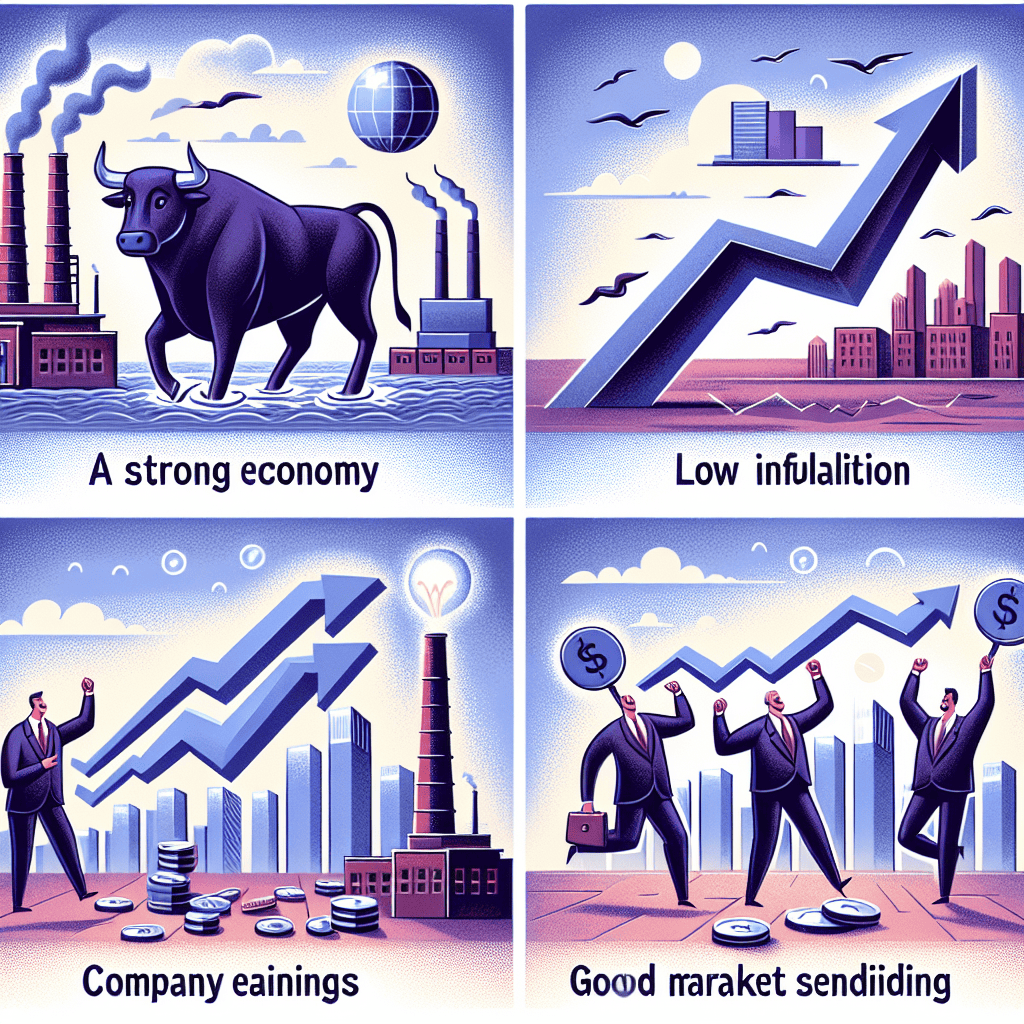“Riding the Wave: Four Key Drivers Fueling the Bull Market’s Momentum”
Introduction
The stock market has long been a barometer of economic health and investor sentiment, and its persistent bull runs often spark debates among analysts and investors. As we navigate the complexities of the current financial landscape, several compelling factors suggest that the bull market could continue its upward trajectory. Firstly, robust corporate earnings have consistently exceeded expectations, providing a solid foundation for stock valuations. Secondly, accommodative monetary policies from central banks worldwide have maintained low interest rates, encouraging investment in equities. Thirdly, technological advancements and innovation continue to drive growth across various sectors, creating new opportunities and enhancing productivity. Lastly, increased consumer spending, fueled by rising wages and employment levels, supports economic expansion and corporate profitability. Together, these elements create a conducive environment for the stock market to sustain its bullish momentum.
Economic Growth: A Catalyst for Sustained Bull Market
The stock market has long been a barometer of economic health, reflecting the collective sentiment of investors regarding future growth prospects. As we navigate through the complexities of the current financial landscape, there are compelling reasons to believe that the bull market could persist, driven primarily by robust economic growth. First and foremost, the global economy is experiencing a resurgence, fueled by technological advancements and increased consumer spending. These factors are contributing to a positive feedback loop, where economic growth bolsters corporate earnings, which in turn supports higher stock valuations. As companies continue to innovate and expand their operations, they are likely to see increased profitability, thereby attracting more investment and sustaining the upward trajectory of the stock market.
Moreover, central banks around the world have adopted accommodative monetary policies, which have played a crucial role in supporting economic growth. Low interest rates and quantitative easing measures have made borrowing more affordable, encouraging both businesses and consumers to invest and spend. This influx of capital into the economy has not only stimulated growth but also provided a favorable environment for equities to thrive. As long as central banks maintain these supportive policies, the stock market is likely to benefit from the increased liquidity and investor confidence that accompany such measures.
In addition to monetary policy, fiscal stimulus has been a significant driver of economic growth, further underpinning the bull market. Governments have implemented various stimulus packages aimed at revitalizing their economies in the wake of recent global challenges. These measures have included direct financial assistance to individuals and businesses, infrastructure investments, and tax incentives, all of which have contributed to increased economic activity. As these fiscal policies continue to take effect, they are expected to bolster consumer confidence and spending, thereby sustaining the momentum of the bull market.
Furthermore, the global economy is becoming increasingly interconnected, with emerging markets playing a more prominent role in driving growth. Countries such as China, India, and Brazil are experiencing rapid economic expansion, fueled by industrialization, urbanization, and a burgeoning middle class. This growth in emerging markets presents new opportunities for multinational corporations, which can tap into these expanding consumer bases to drive revenue and profit growth. As these companies capitalize on the potential of emerging markets, their stock prices are likely to reflect the increased earnings potential, thereby contributing to the persistence of the bull market.
In conclusion, the sustained bull market can be attributed to a confluence of factors, with economic growth serving as a primary catalyst. The combination of technological advancements, accommodative monetary policies, fiscal stimulus, and the rise of emerging markets creates a favorable environment for continued stock market gains. While challenges and uncertainties remain, the underlying strength of the global economy provides a solid foundation for the bull market to persist. As investors navigate this dynamic landscape, they can take solace in the fact that the forces driving economic growth are likely to continue supporting the upward trajectory of the stock market.
Corporate Earnings: The Backbone of Market Resilience
Corporate earnings have long been considered the backbone of market resilience, serving as a critical indicator of the health and sustainability of a bull market. As we delve into the reasons why the current stock bull market could persist, it is essential to examine the role of corporate earnings in this dynamic. First and foremost, robust corporate earnings provide a solid foundation for stock valuations. When companies consistently report strong earnings, it signals to investors that these businesses are effectively managing their operations, generating profits, and potentially offering attractive returns on investment. This, in turn, bolsters investor confidence and encourages further investment in the stock market. As companies continue to demonstrate their ability to grow earnings, it creates a positive feedback loop that supports higher stock prices and sustains the bull market.
Moreover, corporate earnings growth often reflects broader economic strength. When companies report increasing profits, it is frequently a sign that consumer demand is healthy, businesses are investing in expansion, and the overall economy is on an upward trajectory. This economic vitality can be attributed to various factors, such as low unemployment rates, rising consumer spending, and favorable fiscal policies. As long as these conditions persist, they provide a conducive environment for corporate earnings to flourish, thereby underpinning the stock market’s upward momentum.
In addition to reflecting economic health, corporate earnings also play a crucial role in shaping investor expectations. When companies exceed earnings forecasts, it often leads to upward revisions of future earnings estimates, which can drive stock prices higher. This phenomenon is particularly pronounced during earnings season when a wave of positive earnings surprises can create a ripple effect across the market. As investors adjust their expectations based on these results, it can lead to increased buying activity and further fuel the bull market. Consequently, the ability of companies to consistently deliver strong earnings results is a key factor in sustaining investor optimism and market resilience.
Furthermore, corporate earnings provide a buffer against market volatility. In times of uncertainty or external shocks, companies with strong earnings are better positioned to weather the storm. Their financial stability allows them to maintain operations, invest in growth opportunities, and return value to shareholders through dividends and share buybacks. This resilience can help mitigate the impact of market downturns and provide a degree of stability that supports the continuation of the bull market. As investors seek safe havens during turbulent times, companies with solid earnings records become attractive options, further reinforcing the market’s upward trajectory.
In conclusion, corporate earnings are undeniably the backbone of market resilience and play a pivotal role in the persistence of a stock bull market. By providing a foundation for stock valuations, reflecting economic strength, shaping investor expectations, and offering a buffer against volatility, robust corporate earnings contribute significantly to the sustainability of the current market rally. As long as companies continue to deliver strong earnings performance, the stock bull market is likely to persist, driven by the confidence and optimism of investors who recognize the enduring value of these financial indicators.
Technological Innovation: Driving Market Expansion
Technological innovation has long been a cornerstone of economic growth and market expansion, and its role in sustaining the current bull market cannot be overstated. As we delve into the reasons why this upward trend in the stock market could persist, it becomes evident that technological advancements are at the forefront of this momentum. Firstly, the rapid pace of innovation in sectors such as artificial intelligence, biotechnology, and renewable energy is creating new opportunities for growth and investment. Companies that are at the cutting edge of these technologies are not only enhancing their operational efficiencies but are also opening up new revenue streams. This, in turn, attracts investors who are eager to capitalize on the potential for high returns, thereby driving stock prices higher.
Moreover, the digital transformation across industries is reshaping business models and consumer behavior. As more companies adopt digital solutions, they are able to reach wider audiences, streamline operations, and reduce costs. This shift is particularly evident in the e-commerce and fintech sectors, where technological advancements have lowered barriers to entry and increased competition. Consequently, companies that successfully leverage these technologies are likely to experience significant growth, further fueling the bull market. Additionally, the proliferation of data analytics and machine learning tools is enabling businesses to make more informed decisions, optimize their strategies, and enhance customer experiences. This data-driven approach not only boosts profitability but also instills confidence among investors, contributing to sustained market expansion.
Furthermore, the ongoing development of 5G technology is set to revolutionize connectivity and communication. As 5G networks become more widespread, they will facilitate the growth of the Internet of Things (IoT), autonomous vehicles, and smart cities. These advancements are expected to create a ripple effect across various industries, leading to increased productivity and innovation. Investors are keenly aware of the transformative potential of 5G, and as companies position themselves to capitalize on this technology, their stock valuations are likely to rise. The anticipation of future growth driven by 5G-related innovations is a compelling reason for the bull market’s persistence.
In addition to these technological drivers, the global push towards sustainability and clean energy is another factor that could sustain the bull market. As governments and corporations commit to reducing carbon emissions and transitioning to renewable energy sources, there is a growing demand for innovative solutions in this space. Companies that are developing cutting-edge technologies for solar power, wind energy, and energy storage are attracting significant investment. This trend is not only beneficial for the environment but also presents lucrative opportunities for investors, thereby supporting the continuation of the bull market.
In conclusion, technological innovation is a powerful force propelling the current bull market. The rapid advancements in artificial intelligence, digital transformation, 5G technology, and clean energy are creating new avenues for growth and investment. As companies continue to innovate and adapt to these changes, they are likely to experience sustained success, which in turn will attract investors and drive stock prices higher. While market dynamics are influenced by a multitude of factors, the role of technology in shaping the future of the stock market is undeniably significant. As such, the ongoing wave of technological innovation provides a strong foundation for the bull market to persist.
Monetary Policy: Central Banks Supporting Growth

In recent years, the global economy has witnessed a remarkable bull market, with stock indices reaching unprecedented heights. One of the pivotal factors contributing to this sustained growth is the monetary policy adopted by central banks worldwide. Central banks, through their strategic interventions, have played a crucial role in supporting economic growth and, consequently, the stock market’s upward trajectory. Understanding the mechanisms through which central banks influence the economy can provide valuable insights into why the bull market may persist.
Firstly, central banks have maintained historically low interest rates, which have been instrumental in fostering economic expansion. By keeping borrowing costs low, central banks encourage both businesses and consumers to take on loans for investment and spending. This increased economic activity translates into higher corporate earnings, which, in turn, boosts stock prices. Moreover, low interest rates make equities more attractive compared to fixed-income securities, as investors seek higher returns in the stock market. Consequently, the demand for stocks rises, further propelling the bull market.
In addition to low interest rates, central banks have engaged in quantitative easing (QE) programs, which involve the large-scale purchase of government and corporate bonds. This strategy injects liquidity into the financial system, ensuring that banks have ample funds to lend. The increased money supply not only supports lending but also drives investors towards riskier assets, such as stocks, in search of better yields. As a result, QE has been a significant driver of stock market growth, as it enhances liquidity and investor confidence.
Furthermore, central banks have demonstrated a commitment to maintaining economic stability, which reassures investors and supports market growth. By signaling their readiness to intervene in times of economic distress, central banks provide a safety net that mitigates market volatility. This assurance encourages investors to remain engaged in the stock market, even during periods of uncertainty. The perception of central banks as stabilizing forces fosters a positive investment climate, contributing to the persistence of the bull market.
Moreover, central banks’ forward guidance has become an essential tool in shaping market expectations. By communicating their future policy intentions, central banks reduce uncertainty and help investors make informed decisions. This transparency allows market participants to anticipate changes in monetary policy and adjust their strategies accordingly. As a result, forward guidance minimizes abrupt market reactions and supports a more stable investment environment. The clarity provided by central banks’ communication strategies further bolsters investor confidence, sustaining the bull market.
In conclusion, the monetary policies implemented by central banks have been instrumental in supporting the ongoing bull market. Through low interest rates, quantitative easing, a commitment to economic stability, and forward guidance, central banks have created an environment conducive to stock market growth. These measures not only stimulate economic activity but also enhance investor confidence, driving demand for equities. As long as central banks continue to prioritize growth and stability, the conditions that have fueled the bull market are likely to persist. Consequently, understanding the role of central banks in shaping economic and market dynamics is crucial for investors seeking to navigate the complexities of the current financial landscape.
Consumer Confidence: Fueling Market Optimism
Consumer confidence plays a pivotal role in shaping the trajectory of financial markets, acting as a barometer for economic health and a catalyst for market movements. As we explore the reasons why the current stock bull market could persist, it is essential to consider how consumer confidence fuels market optimism. This sentiment, often measured through various indices and surveys, reflects the public’s perception of economic stability and their willingness to spend, invest, and take financial risks. When consumer confidence is high, it can lead to increased consumer spending, which in turn drives corporate earnings and supports higher stock valuations.
Firstly, robust consumer confidence often translates into heightened consumer spending, a critical component of economic growth. When individuals feel secure in their financial prospects, they are more likely to make significant purchases, such as homes, cars, and other durable goods. This spending not only boosts the revenues of companies in these sectors but also has a ripple effect across the economy, benefiting a wide range of industries. As companies report strong earnings, investor sentiment tends to improve, further propelling stock prices upward. Consequently, the positive feedback loop between consumer confidence and corporate performance can sustain a bull market.
Moreover, consumer confidence can influence investment behavior, encouraging individuals to allocate more of their savings into equities. When people are optimistic about the economy, they are more inclined to invest in the stock market, seeking higher returns than those offered by traditional savings accounts or bonds. This influx of capital can drive stock prices higher, as increased demand for equities pushes valuations upward. Additionally, as more individuals participate in the market, the increased liquidity can reduce volatility, making the market more attractive to both retail and institutional investors.
In addition to driving spending and investment, consumer confidence can also impact corporate decision-making. Companies are more likely to expand operations, hire additional staff, and invest in new projects when they perceive a stable and growing consumer base. This corporate optimism can lead to increased productivity and innovation, further enhancing the long-term prospects of the economy and the stock market. As businesses thrive, they contribute to a virtuous cycle of growth, reinforcing consumer confidence and sustaining the bull market.
Finally, it is important to consider the role of government policy in shaping consumer confidence. Fiscal and monetary policies that support economic stability and growth can bolster public sentiment, encouraging spending and investment. For instance, low interest rates can make borrowing more attractive, prompting consumers to finance large purchases and businesses to invest in expansion. Similarly, government stimulus measures can provide a safety net during economic downturns, helping to maintain consumer confidence even in challenging times. As policymakers continue to prioritize economic growth, their actions can provide a supportive backdrop for the stock market.
In conclusion, consumer confidence is a critical driver of market optimism, influencing spending, investment, corporate behavior, and policy decisions. As long as consumer confidence remains strong, it can provide the necessary fuel to sustain the current stock bull market. By understanding the intricate relationship between consumer sentiment and market dynamics, investors can better navigate the complexities of the financial landscape and capitalize on opportunities for growth.
Global Trade: Opportunities for Market Expansion
The global trade landscape has long been a cornerstone of economic growth, providing a fertile ground for market expansion and, consequently, fueling stock market rallies. As we delve into the reasons why the current bull market could persist, it is essential to consider the role of global trade in this dynamic. Firstly, the ongoing expansion of international trade agreements continues to open new markets for businesses worldwide. These agreements reduce tariffs and trade barriers, allowing companies to access a broader customer base and diversify their revenue streams. As businesses grow and thrive in these new markets, their financial performance improves, which in turn boosts investor confidence and drives stock prices higher.
Moreover, technological advancements have revolutionized the way global trade is conducted, further supporting market expansion. Innovations in logistics, communication, and data management have streamlined supply chains and enhanced efficiency, enabling companies to operate more effectively on a global scale. This increased efficiency not only reduces costs but also enhances the competitiveness of businesses in international markets. As companies leverage technology to optimize their operations, they become more attractive to investors, contributing to the sustained momentum of the bull market.
In addition to technological advancements, the rise of emerging markets presents another compelling reason for the persistence of the bull market. Countries in Asia, Africa, and Latin America are experiencing rapid economic growth, driven by industrialization, urbanization, and a burgeoning middle class. These emerging markets offer significant opportunities for companies seeking to expand their global footprint. As businesses tap into these high-growth regions, they can achieve substantial revenue growth, which is reflected in their stock valuations. Consequently, the allure of emerging markets continues to attract investors, providing further impetus for the bull market.
Furthermore, the increasing focus on sustainability and environmental responsibility is reshaping global trade and creating new avenues for market expansion. As consumers and governments worldwide demand more sustainable practices, companies are compelled to innovate and adapt. This shift towards sustainability is driving the development of new products and services, opening up fresh markets and opportunities for growth. Companies that successfully integrate sustainability into their business models are likely to enjoy a competitive advantage, attracting investment and supporting the ongoing bull market.
In conclusion, the interplay of expanding international trade agreements, technological advancements, the rise of emerging markets, and the growing emphasis on sustainability collectively underpin the potential for the current bull market to persist. As global trade continues to evolve, it presents myriad opportunities for businesses to expand and thrive, ultimately benefiting investors and sustaining the upward trajectory of stock markets. While challenges and uncertainties remain, the fundamental drivers of market expansion through global trade provide a solid foundation for optimism. As such, investors and market participants should remain vigilant, yet optimistic, as they navigate the complexities of the global economic landscape.
Demographic Trends: Long-term Market Drivers
The persistence of a bull market often hinges on a multitude of factors, and among these, demographic trends stand out as significant long-term drivers. As we delve into the reasons why the current stock bull market could continue, it is essential to consider how demographic shifts influence economic growth and, consequently, market dynamics. One of the primary demographic trends contributing to the sustained bull market is the aging population in developed countries. As the baby boomer generation enters retirement, there is an increased demand for income-generating investments, such as stocks. This demographic shift leads to a greater allocation of assets into equities, as retirees seek to maintain their standard of living through dividend income and capital appreciation. Consequently, this sustained demand for stocks can help support market valuations and drive further growth.
In addition to the aging population, the rise of the millennial generation as a significant economic force cannot be overlooked. Millennials, now entering their peak earning years, are poised to become the largest demographic group in the workforce. This generation’s increasing purchasing power and investment activity are likely to have a profound impact on the stock market. As millennials prioritize financial planning and investment, their participation in the stock market is expected to grow. This influx of new investors can provide additional liquidity and support for the bull market, as their long-term investment horizon aligns with the continued growth of equities.
Moreover, the globalization of financial markets has facilitated greater access to investment opportunities for individuals worldwide. As emerging markets continue to develop, a growing middle class is gaining access to financial markets, further fueling demand for equities. This global expansion of the investor base not only diversifies the sources of capital but also enhances market stability. The increased participation of international investors can help mitigate regional economic downturns, thereby contributing to the resilience of the bull market.
Furthermore, technological advancements have revolutionized the way individuals invest, making it easier and more efficient to participate in the stock market. The proliferation of online trading platforms and robo-advisors has democratized access to financial markets, enabling a broader demographic to invest in stocks. This technological shift has lowered barriers to entry and increased market participation, particularly among younger investors who are more comfortable with digital platforms. As technology continues to evolve, it is likely to attract even more participants to the stock market, providing additional support for the bull market’s persistence.
In conclusion, demographic trends play a crucial role in shaping the long-term trajectory of the stock market. The aging population’s demand for income-generating investments, coupled with the rising economic influence of millennials, creates a robust foundation for continued market growth. Additionally, the globalization of financial markets and technological advancements further bolster market participation and stability. While no market trend is guaranteed to persist indefinitely, these demographic factors suggest that the current bull market has the potential to endure. As investors navigate the complexities of the financial landscape, understanding these demographic drivers can provide valuable insights into the future direction of the stock market.
Q&A
1. **Economic Growth**: Continued economic expansion can drive corporate earnings higher, supporting stock prices. Factors such as consumer spending, business investments, and government policies can contribute to sustained growth.
2. **Low Interest Rates**: Persistently low interest rates make borrowing cheaper for companies and consumers, encouraging investment and spending. This environment also makes stocks more attractive compared to bonds, driving more investment into equities.
3. **Technological Advancements**: Ongoing innovation and technological advancements can lead to increased productivity and the creation of new markets, boosting corporate profits and stock valuations.
4. **Strong Corporate Earnings**: Companies consistently reporting strong earnings can maintain investor confidence and drive stock prices higher. This can be fueled by cost-cutting measures, expanding into new markets, or launching new products and services.
5. **Global Economic Recovery**: As global economies recover from downturns, increased trade and investment can bolster corporate earnings and stock markets worldwide.
6. **Fiscal Stimulus**: Government spending and stimulus measures can inject liquidity into the economy, supporting consumer demand and business growth, which in turn can sustain the bull market.
7. **Investor Sentiment**: Positive investor sentiment and confidence in the market can lead to increased buying activity, further driving up stock prices. This can be influenced by factors such as geopolitical stability and favorable economic indicators.
Conclusion
The stock bull market could persist due to several key factors. Firstly, continued economic growth, driven by robust consumer spending and business investments, can sustain corporate earnings and investor confidence. Secondly, accommodative monetary policies, such as low interest rates and quantitative easing, provide liquidity and encourage investment in equities. Thirdly, technological advancements and innovation across various sectors can drive productivity and create new growth opportunities, attracting investors. Lastly, global economic recovery, particularly in emerging markets, can enhance trade and investment flows, supporting market expansion. These factors collectively suggest that the bull market has the potential to endure, barring significant economic or geopolitical disruptions.





